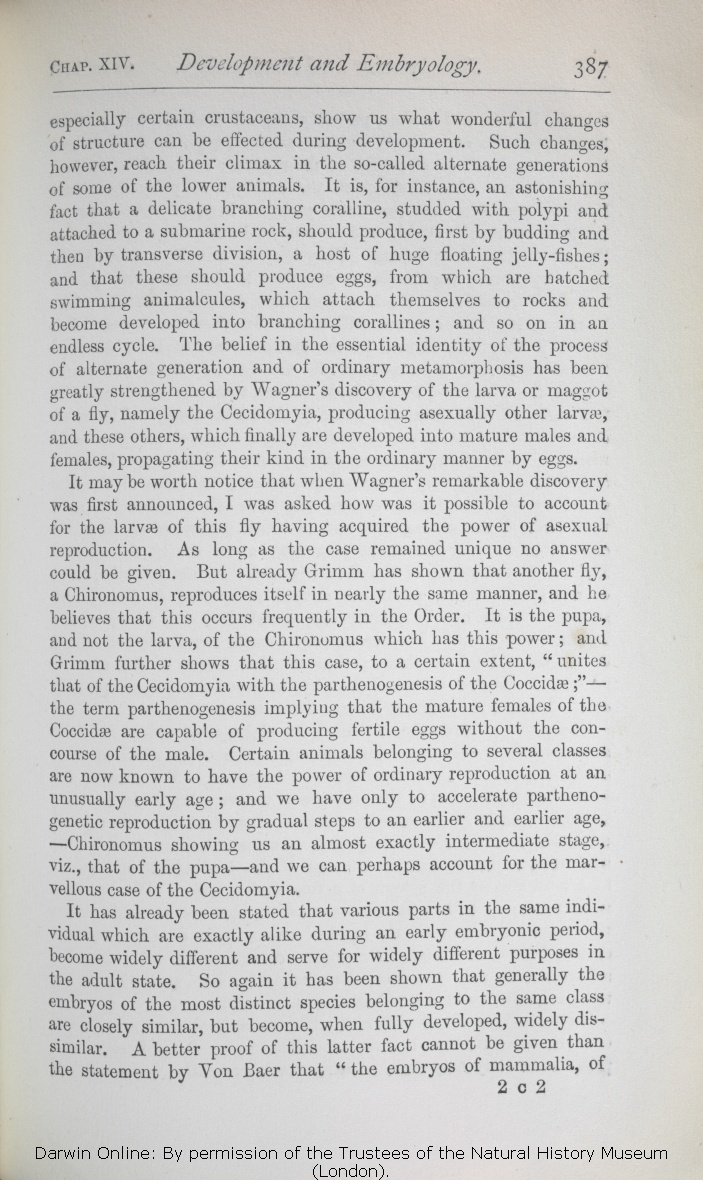especially certain crustaceans, show us what wonderful changes of structure can be effected during development. Such changes, however, reach their climax in the so-called alternate generations of some of the lower animals. It is, for instance, an astonishing fact that a delicate branching coralline, studded with polypi and attached to a submarine rock, should produce, first by budding and then by transverse division, a host of huge floating jelly-fishes; and that these should produce eggs, from which are hatched swimming animalcules, which attach themselves to rocks and become developed into branching corallines; and so on in an endless cycle. The belief in the essential identity of the process of alternate generation and of ordinary metamorphosis has been greatly strengthened by Wagner's discovery of the larva or maggot of a fly, namely the Cecidomyia, producing asexually other larvæ, and these others, which finally are developed into mature males and females, propagating their kind in the ordinary manner by eggs. ↑| 3 blocks not present in 1859 1860 1861 1872; present in 1866 1869 | | What great
changes of structure are
effected during the
development
of some animals is seen in the case of insects, but still more plainly with many crustaceans. When, however, we read of the several wonderful cases, recently discovered, of
the so-called alternate generations of animals, we come to the climax of developmental transformation.
What fact can be more astonishing than
that a delicate branching coralline, studded with polypi and attached to a submarine rock, should produce, first by budding and then by transverse division, a host of huge floating jelly-fishes; and that these should produce eggs, from which are hatched swimming animalcules, which attach themselves to rocks and become developed into branching corallines; and so on in an endless cycle?
|
| 1 blocks not present in 1859 1860 1861 1869 1872; present in 1866 | | Hence it will be seen that I follow those naturalists who look at all cases of alternate generation, as essentially modifications of the process of budding, which may supervene at any stage of development.
|
|
It may be worth notice that when Wagner's remarkable discovery was first announced, I was asked how was it possible to account for the larvæ of this fly having acquired the power of asexual reproduction. As long as the case remained unique no answer could be given. But already Grimm has shown that another fly, a Chironomus, reproduces itself in nearly the same manner, and he believes that this occurs frequently in the Order. It is the pupa, and not the larva, of the Chironomus which has this power; and Grimm further shows that this case, to a certain extent, "unites that of the Cecidomyia with the parthenogenesis of the Coccidæ;"— the term parthenogenesis implying that the mature females of the Coccidæ are capable of producing fertile eggs without the concourse of the male. Certain animals belonging to several classes are now known to have the power of ordinary reproduction at an unusually early age; and we have only to accelerate parthenogenetic reproduction by gradual steps to an earlier and earlier age,— Chironomus showing us an almost exactly intermediate stage, viz., that of the pupa— and we can perhaps account for the marvellous case of the Cecidomyia. ↑| Subtitle not present 1866 1869 1872 |
|
Embryology
.— 1859 1860 1861 |
|
It has already been
stated that various parts | stated that various parts 1872 |
| casually remarked that certain organs 1859 1860 1861 |
| remarked that various parts and organs of the same individual animal are during an early embryonic period exactly like each other, but become 1866 |
| stated that various parts and organs 1869 |
| same individual which are exactly alike during an early embryonic period, become widely different and serve for widely different purposes in the adult state. 1872 |
| individual, which when mature become widely different and serve for different purposes, are in the embryo exactly alike. 1859 1860 1861 |
| adult state widely different and serve for widely different purposes. 1866 |
| same individual are exactly like each other during an early embryonic period, but in the adult state become widely different and serve for widely different purposes. 1869 |
| ..... 1869 1872 | | already 1866 |
| shown 1872 | | remarked 1866 | | stated 1869 |
| generally the 1872 | | the 1866 1869 |
| the most distinct species belonging to 1872 |
| distinct species and genera within 1866 |
| the most distinct species within 1869 |
| ..... 1872 | | generally 1866 1869 |
| become, 1872 | | become 1866 1869 |
| developed, 1872 | | developed 1866 1869 |
| the statement 1872 | | that 1866 1869 |
| ..... 1872 | | namely, 1866 1869 |
|









